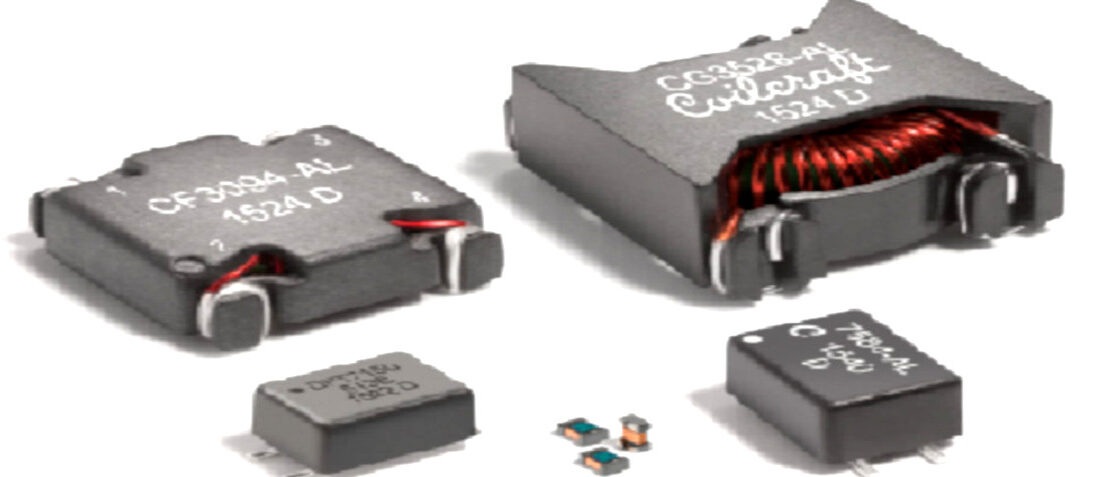
A Guide to Understanding Common Mode Chokes
- Posted by doEEEt Media Group
- On July 30, 2019
- 0
A common mode choke is an electrical filter that blocks high frequency noise common to two or more data or power lines while allowing the desired DC or low-frequency signal to pass. Common mode (CM) noise current is typically radiated from sources such as unwanted radio signals, unshielded electronics, inverters and motors. Left unfiltered, this noise presents interference problems in electronics and electrical circuits.
In normal or differential mode (single choke), current travels on one line in one direction from the source to the load, and in the opposite direction on the return line that completes the circuit. In common mode, the noise current travels on both lines in the same direction.
Common mode chokes have the two or more windings arranged such that the common mode current creates a magnetic field that opposes any increase in common mode current. This is similar to how single line (differential) inductors function. Inductors create magnetic fields that oppose changes in current.
In common mode, the current in a group of lines travels in the same direction so the combined magnetic flux adds to create an opposing field to block the noise, as illustrated by the red and green arrows in the toroid core shown in Figure 1. In differential mode, the current travels in opposite directions and the flux subtracts or cancels out so that the field does not oppose the normal mode signal.

ALTER TECHNOLOGY
Laboratory Services
ALTER laboratory services include parts procurement to equipment testing, including packaging design and assembly, screening, DPA, qualification, evaluation of counterfeits, and many more.
How do I Choose a Common Mode Choke?
The main criteria for selecting a common mode choke are:
- Required impedance: How much attenuation of noise is needed?
- Required frequency range: Over what frequency bandwidth is the noise?
- Required current-handling: How much differential mode current must it handle?
High-Speed and Super-Speed Data Line EMI Chokes
USB, high-speed and Super-Speed data line common mode chokes effectively reduce common mode noise in high-speed interfaces like USB 2.0, USB 3.1 Gen 1, HDMI, IEEE 1394, LVDS, HDBaseTTM, MOST® bus, etc. They maintain excellent signal integrity for high-speed communications with -3 dB differential mode cutoff frequencies up to 6.5 GHz. Most provide greater than 30 dB common mode attenuation at 500 MHz and 25 dB in the GHz band.
Data Line Common Mode EMI Chokes
Surface mount data line common mode chokes are designed to attenuate common mode noise up to 100 MHz. The PDLF Series can reduce noise by a factor of 32 from 15 MHz to 300 MHz and are available in 2, 3 and 4 line versions. The PTRF Series is optimized for FCC and ITU-T (formerly CCITT) requirements. These parts provide 15 to 25 dB attenuation, greater than 1000 Ohms impedance and 1500 V isolation between windings. M2022 can suppress common-mode noise up to 500 MHz in a compact 1812 package.
Data/Power Line Common Mode EMI Chokes
LPD, MSD and PFD Families are low profile, miniature footprint common mode chokes that can be used to attenuate common mode noise or differential mode noise in both data and power line applications.
Surface Mount Power Line Common Mode EMI Chokes
Low-cost, high performance surface mount power line common mode chokes come in a variety of sizes and packages. They are designed to eliminate AC line-conducted common mode noise across a broad range of frequencies, with up to 1500 Vrms isolation. These common mode chokes can operate over a wide range of current from 0.06 Amps to 15 Amps, providing attenuation where line filtering is needed, such as in switch-mode power supplies.
Through-Hole Power Line Common Mode EMI Chokes
Low-cost through-hole BU Series high efficiency choke coils are designed to eliminate line conducted common mode noise across a broad range of frequencies. The BU9S and BU9HS are ideal for signal line applications; the other BUs can be used in switching power supplies and power supply circuits. For low profile applications, the BU9 and BU9S filters are available in a horizontal configuration that reduces their height to under half an inch (12.5 mm).
CMT Common Mode EMI Chokes
CMT toroid style common mode chokes are designed to provide the highest common mode impedance over the widest frequency range. These parts are ideal for any application requiring a high DC current bias and are well suited for use in switch-mode power supplies. These common mode chokes are most effective in filtering supply and return conductors with in-phase signals of equal amplitude. Differential mode inductors are available for filtering out-ofphase or uneven amplitude signals.
Source: Coilcraft article
Article on Coilcraft website: A Guide to Understanding Common Mode Chokes – Written by Chris Hare
GET IN TOUCH TODAY!
Do you have questions? Contact us!
- Space-Grade components available for immediate delivery - April 10, 2025
- Exclusive stock on doEEEt: How to access and request - April 10, 2025
- Managing EEE components for LEO and lower cost space missions - December 17, 2024

0 comments on A Guide to Understanding Common Mode Chokes